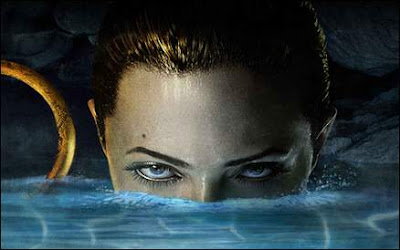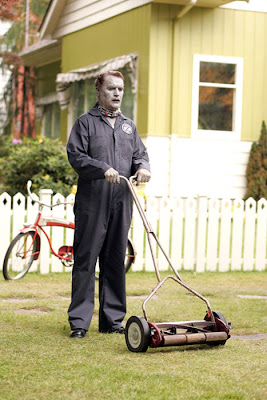
Giselle: Amy Adams
Robert Philip: Patrick Dempsey
Prince Edward: James Marsden
Nathaniel: Timothy Spall
Morgan Philip: Rachel Covey
Nancy Tramaine: Idina Menzel
Queen Narissa: Susan Sarandon
Walt Disney Pictures presents a film directed by Kevin Lima. Written by Bill Kelly. Songs by Alan Menken and Stephen Schwartz. Running time: 107 min. Rated PG (some scary images and mild innuendo).
Ever since her Oscar nominated role as the endlessly positive pregnant sister-in-law in “Junebug” Hollywood has been duty bound to find a leading role for the brilliant Amy Adams. I’m sure fans of that slice-of-life independent dramedy never expected that the role would come in the form of a Disney fairytale princess, but there couldn’t be a better actress to play a cartoon princess who suddenly finds herself stuck in a real life Manhattan. “Enchanted” is a Disney animated musical come to life, and it is aptly enchanting.
Adams plays a fair maiden, in cartoon form at first, who sings to her woodland friends about finding the perfect man with which to share first love’s kiss and live happily ever after. Her name is Giselle―not a very princess-like name in my opinion―and she meets her prince charming in the form of Prince Edward. Unfortunately, Edward is the nephew of the evil Queen Narissa, who pushes Giselle down a magic well on her wedding day so she can retain her crown.
Giselle comes out the other end of the magic well through a manhole cover in the middle of Manhattan. She soon meets another prince charming in the form of Robert Philip, a divorce lawyer with issues about spontaneity in a relationship. To throw in the required amount of romantic fantasy obstacles, Robert is a single father with a girlfriend. Also, Edward follows Giselle down the well to save her from her fate, as his stereotypical hero role requires. And Narissa sends her henchman Nathaniel to New York to ensure Edward fails.
Many romantic comedies might ask you to take this stew of clichés seriously, but “Enchanted” has a great deal of fun sending up the very conventions its studio spent so many years establishing. Even before the characters get to Manhattan, the animators and musicians are having fun with the cartoon clichés of singing animals and Giselle’s ridiculous ideals for a perfect man.
But it’s during the live action portion where the filmmakers have the most fun. Upon her arrival in New York, Giselle once again enlists the help of animal friends by singing to them in the wonderful number “Happy Working Song”. Instead of all the colorful woodland personalities of the animated forest, the Manhattan wildlife consists primarily of pigeons, rats and cockroaches. Adams’ reaction to her newfound musical help is exactly what makes her perfect for this role―a little astonished at the class of animal but willing to forgive them their appearance for their help.
The film has fun with Giselle’s cartoony apparel and with Edward’s earnest and overblown approach to challenges, and that gets us to why this film really works so well. The cast is wholly committed to this strange enterprise. With the film’s funniest portrayal as Prince Edward, James Marsden (“X-Men”) proves how underrated he is as a handsome hunk. Susan Sarandon (“Mr. Woodcock”) eats every hunk of scenery she can wrap her jaws around as the evil queen. Timothy Spall (“Harry Potter” series) shows off his clownishness as the queen’s henchman and gives him just a hint of sympathy. And I would almost say Patrick Dempsey has the thankless task of being the only real person in the movie except that he is here in his official capacity as the “McDreamy” persona that has revitalized his career on “Grey’s Anatomy”, and that can hardly be considered thankless.
As I watched “Enchanted” I was reminded of all the Broadway shows being produced from old Disney material and various other films lately. It is a little depressing to think that Broadway is so starved for marketable material that it must turn to another medium that so egregiously steals from other sources for its commercial inspiration. To think of “The Incredibles” or some other such animated hit becoming the next big Broadway hit is enough to turn my stomach (and please tell me I didn’t just give some producer his next great idea). But the thought of a Broadway version of this movie is actually quite invigorating. They could just use the same opening animated sequences and when Giselle arrives in Manhattan the stage will light up with life. There are already a couple of memorable musical numbers, which could easily be added to with the continued skills of Alan Menken and Stephen Schwartz. And I don’t even like watching theater, so if this simple film could inspire thoughts like that in me, it must be doing something right.
Robert Philip: Patrick Dempsey
Prince Edward: James Marsden
Nathaniel: Timothy Spall
Morgan Philip: Rachel Covey
Nancy Tramaine: Idina Menzel
Queen Narissa: Susan Sarandon
Walt Disney Pictures presents a film directed by Kevin Lima. Written by Bill Kelly. Songs by Alan Menken and Stephen Schwartz. Running time: 107 min. Rated PG (some scary images and mild innuendo).
Ever since her Oscar nominated role as the endlessly positive pregnant sister-in-law in “Junebug” Hollywood has been duty bound to find a leading role for the brilliant Amy Adams. I’m sure fans of that slice-of-life independent dramedy never expected that the role would come in the form of a Disney fairytale princess, but there couldn’t be a better actress to play a cartoon princess who suddenly finds herself stuck in a real life Manhattan. “Enchanted” is a Disney animated musical come to life, and it is aptly enchanting.
Adams plays a fair maiden, in cartoon form at first, who sings to her woodland friends about finding the perfect man with which to share first love’s kiss and live happily ever after. Her name is Giselle―not a very princess-like name in my opinion―and she meets her prince charming in the form of Prince Edward. Unfortunately, Edward is the nephew of the evil Queen Narissa, who pushes Giselle down a magic well on her wedding day so she can retain her crown.
Giselle comes out the other end of the magic well through a manhole cover in the middle of Manhattan. She soon meets another prince charming in the form of Robert Philip, a divorce lawyer with issues about spontaneity in a relationship. To throw in the required amount of romantic fantasy obstacles, Robert is a single father with a girlfriend. Also, Edward follows Giselle down the well to save her from her fate, as his stereotypical hero role requires. And Narissa sends her henchman Nathaniel to New York to ensure Edward fails.
Many romantic comedies might ask you to take this stew of clichés seriously, but “Enchanted” has a great deal of fun sending up the very conventions its studio spent so many years establishing. Even before the characters get to Manhattan, the animators and musicians are having fun with the cartoon clichés of singing animals and Giselle’s ridiculous ideals for a perfect man.
But it’s during the live action portion where the filmmakers have the most fun. Upon her arrival in New York, Giselle once again enlists the help of animal friends by singing to them in the wonderful number “Happy Working Song”. Instead of all the colorful woodland personalities of the animated forest, the Manhattan wildlife consists primarily of pigeons, rats and cockroaches. Adams’ reaction to her newfound musical help is exactly what makes her perfect for this role―a little astonished at the class of animal but willing to forgive them their appearance for their help.
The film has fun with Giselle’s cartoony apparel and with Edward’s earnest and overblown approach to challenges, and that gets us to why this film really works so well. The cast is wholly committed to this strange enterprise. With the film’s funniest portrayal as Prince Edward, James Marsden (“X-Men”) proves how underrated he is as a handsome hunk. Susan Sarandon (“Mr. Woodcock”) eats every hunk of scenery she can wrap her jaws around as the evil queen. Timothy Spall (“Harry Potter” series) shows off his clownishness as the queen’s henchman and gives him just a hint of sympathy. And I would almost say Patrick Dempsey has the thankless task of being the only real person in the movie except that he is here in his official capacity as the “McDreamy” persona that has revitalized his career on “Grey’s Anatomy”, and that can hardly be considered thankless.
As I watched “Enchanted” I was reminded of all the Broadway shows being produced from old Disney material and various other films lately. It is a little depressing to think that Broadway is so starved for marketable material that it must turn to another medium that so egregiously steals from other sources for its commercial inspiration. To think of “The Incredibles” or some other such animated hit becoming the next big Broadway hit is enough to turn my stomach (and please tell me I didn’t just give some producer his next great idea). But the thought of a Broadway version of this movie is actually quite invigorating. They could just use the same opening animated sequences and when Giselle arrives in Manhattan the stage will light up with life. There are already a couple of memorable musical numbers, which could easily be added to with the continued skills of Alan Menken and Stephen Schwartz. And I don’t even like watching theater, so if this simple film could inspire thoughts like that in me, it must be doing something right.

















